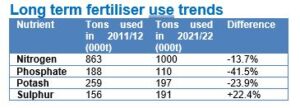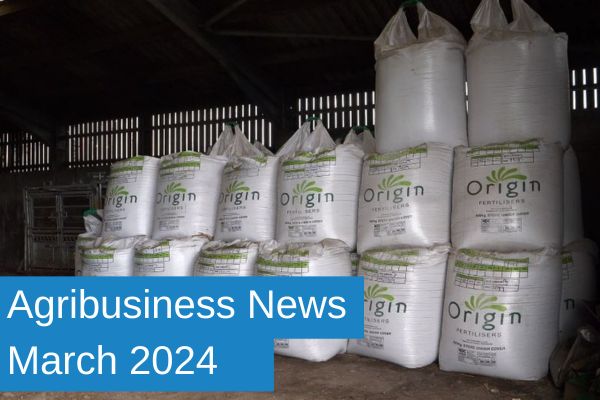Agribusiness News March 2024 – Input Costs: Fertiliser
1 March 2024Market update
It is a welcome relief that fertiliser prices have stabilised and the outlook for the coming season looks to be more settled. However, given the rollercoaster in prices we have seen over the last two years it would be prudent to be prepared for future fluctuations.
UK agriculture is now more reliant on imports than ever before with Ammonium Nitrate production at CF Fertilisers English sites now using imported Ammonia. Added to the pressure on imports is the reduction in available product as merchants chose to avoid Russian nitrogen. Bulk delivery of fertiliser products into UK blenders takes approximately 4 weeks from source so supplies in the UK are still tight. Whilst the price has stabilised suppliers are warning to allow at least 2 weeks for delivery this spring, we all know the most expensive fertiliser is the one that isn’t on farm when you need it.
Current pricing
Market prices for full loads delivered are quoted as:
- Urea – £360-£365
- Imported AN – £345-£350
- Nitram – £330-£335 (April delivery)
- MOP – £380-£390
- TSP – £430-£435
- DAP – £570-£575
New season prices are expected in June with Nitrogen prices expected to remain fluid. MOP currently being imported from Germany and TSP from Morocco appear to be more settled.

The eye watering costs of 2022 and 2023 prompted or forced many farmers into thinking differently and reducing their fertiliser use. It is anticipated that fertiliser use in 2023 was down 20%, a marked reduction from the trend seen in the preceding 10 years. The table above shows the difference in use key nutrients applied in the UK between 2012 and 2022 as reported by AIC fertiliser statistics report 2023.
Sustaining lower inputs
Lower fertiliser use is good for the pocket and good for the environment, but we must consider how we make reduced use sustainable for our businesses in the long term. Sustainable reductions in fertiliser can be achieved through considering the following management practices:
- Maintaining an appropriate soil pH, phosphate, and potash levels for optimum availability of nutrients;
- Ensuring good soil structure encouraging healthy roots and uptakes of nutrient;
- Inclusion of legumes in rotations and grass swards;
- Applying nitrogen in suitable conditions when crop response will be greatest;
- Preparing feed budgets and measuring yields to match supply with demand of forage;
- Using yield information to assess response to N applications and establish an optimum rate;
- Maintaining equipment and using technology to reduce waste and emissions;
- Making better use of organic manures and other available nutrients through analysis and preparation of an annual nutrient management plan;
- Including sulphur in grades to optimise nitrogen uptake;
- Targeting applications to the crops and grasses which will provide the greatest response.
There will still be plenty of fertiliser orders to go in for this spring especially for grassland and where the outcome of winter sown crops is still to be determined but when considering what to buy and when to buy, please remember to;
- Allow at least 2 weeks for delivery and longer as orders volumes increase;
- Ensure you have submitted your photo identification to enable your order to be released after changes to the Control of Poisons and Explosives Precursors Regulations 2023 were imposed in October 2023.
Consider your recent fertiliser use and if it sustainable – cheap nitrogen can be tempting but this can mask some underlying issues.
lorna.galloway@sac.co.uk
Sign up to the FAS newsletter
Receive updates on news, events and publications from Scotland’s Farm Advisory Service

